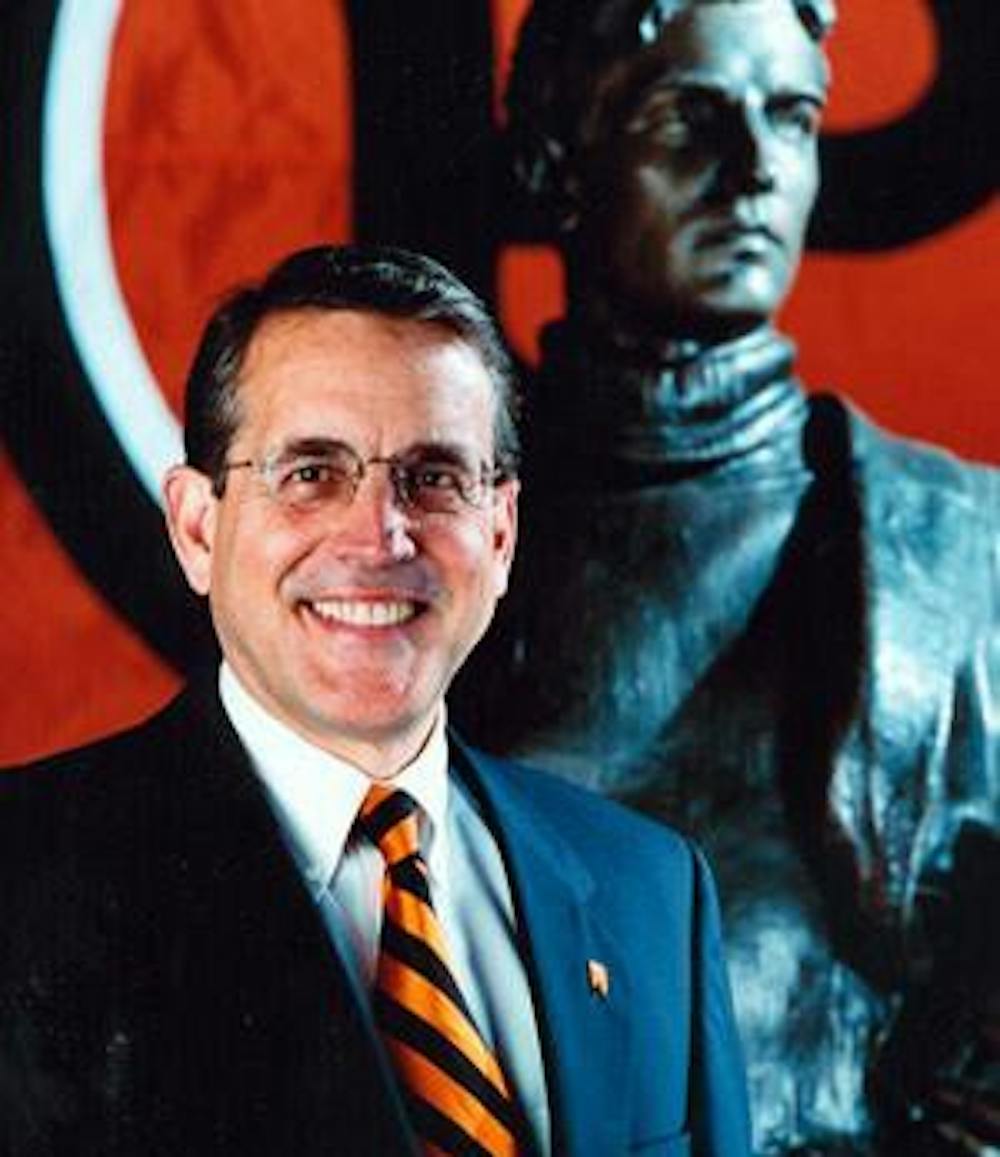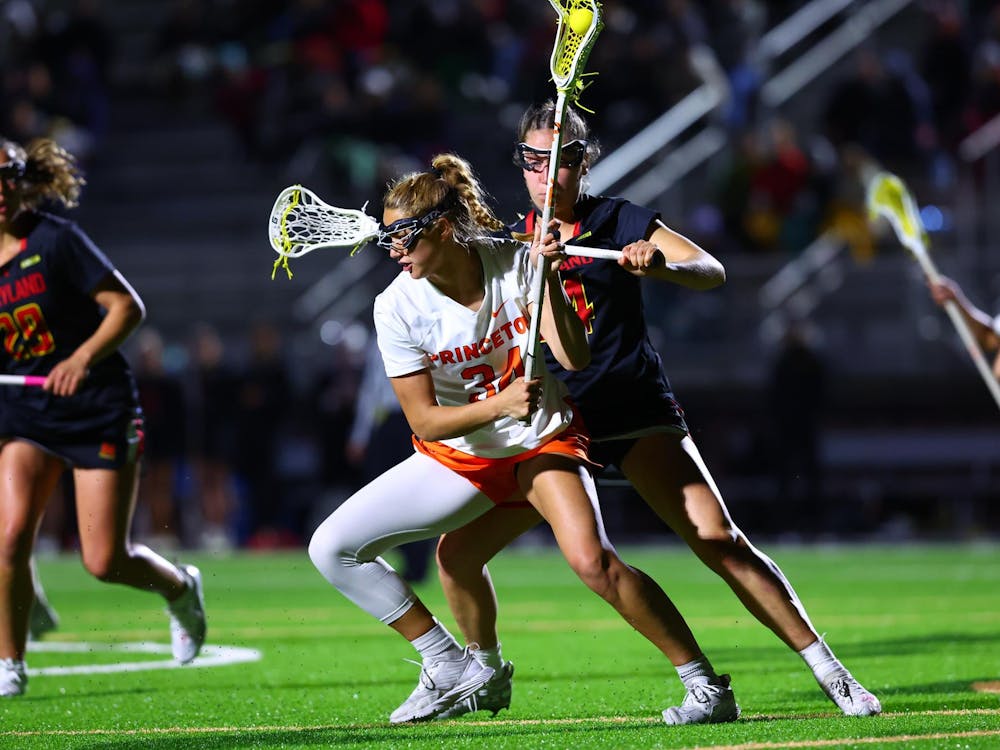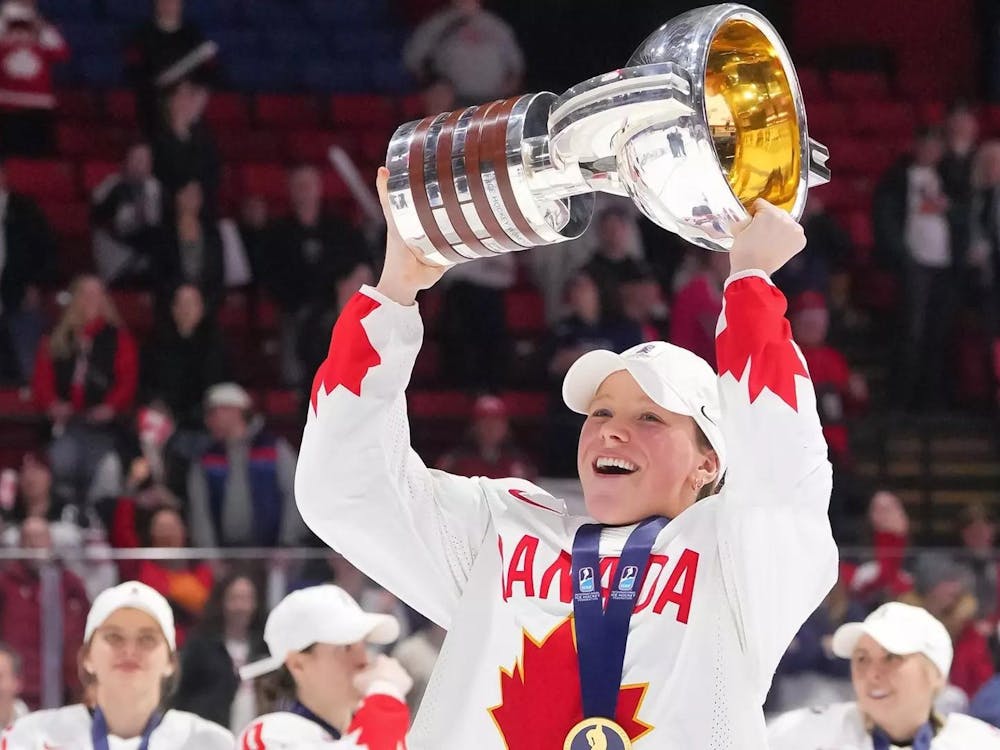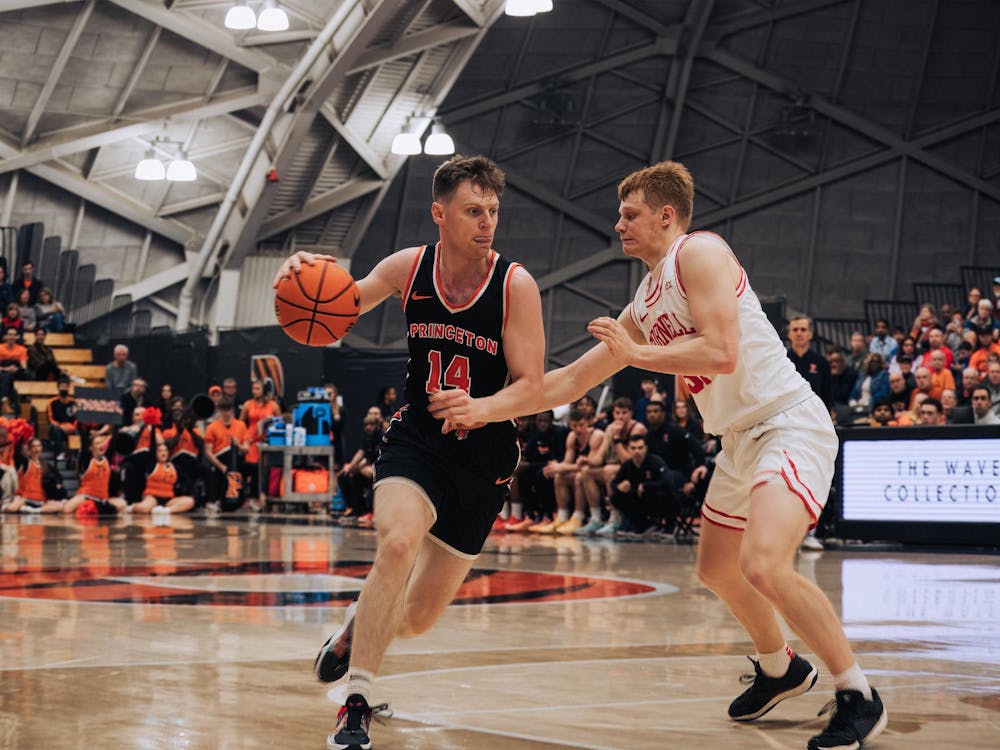 Princeton sports were in trouble.
Princeton sports were in trouble.
In 1992, the University’s vice president penned a study bringing varsity athletics under the microscope. In 1993, a strategic plan encouraged the University to “rethink” athletics’ role at Princeton. And in 1994, it was the Board of Trustees’ turn to scrutinize: Should Princeton be socommitted to varsity athletics?
It hired Gary Walters ’67 as athletic director.
Over the past 20 years, Walters largely squashed that stream of skepticism —as often with a disarming, tireless charm offensive as with aggressive, brute force. Walters could pepper faculty members sympathetic to athletics with the latest reads on athletic leadership until they were sending him links. But he could also re-emerge as a competitor, outmuscling those who threatened his turf.
This is Walters’ last year, and his 51st since arriving on campus as the lightning fast point guard who would in 1965 lead the basketball team to the Final Four. And a review of Walters’ tenure reveals a series of victories over both his critics and the broader criticisms of Princeton’s athletic program. By recasting athletics as a form of character education, Walters has tried to argue that what happens in the classroom and on the playing fields isn’t all that different.
“If we’re not contributing to the educational mission of Princeton, we shouldn’t do athletics,” he said in an interview. “We shouldn’t do it,” he repeated.
When Walters, known as a forceful personality and a garrulous intellect, announced his retirement in September, the compliments from administrators, coaches and faculty flowed. But this applause belies how controversial Walters was at times in nearly every pocket of Princeton. Faculty questioned why Walters’ recruited athletes occupied up to 20 percent of Princeton admission slots. Administrators questioned whether Princeton’s athletic accomplishments were becoming a distraction from the school'score educational focus.
Most prominently, a former Princeton president waged war on the value of big-time intercollegiate athletics, galvanizing the critics who said so privately. For a few years in the early 2000s, it looked like Walters’ narrative had begun to unravel. And for a moment, he looked for Princeton’s exit signs.
What relationship?
Before Gary Walters became Princeton’s athletic director, there was not a tense relationship between the athletic and academic sides of the University. There just wasn’t much of a relationship at all.
“Our job was to run the athletics department. Our job wasn’t to integrate student-athletes with the rest of the University,” Myslik said.

Myslik was only the University’s third athletic director, a position created in 1941. Soon after he arrived in 1979, it was clear to him that the University did not fully embrace its athletic program: When Myslik petitioned the Dean of the Faculty, Aaron Lemonick, to let the Director of Athletics walk in the procession during Commencement exercises like other administrators did, Lemonick denied his request. It took the intervention of University President Bill Bowen GS ’58 to earn Myslik a spot on the stage.
“There were very few, if any, faculty members, I would bet, who would have been willing to stand up at a faculty meeting and say anything positive about athletics,” Myslik said. “And I’m not saying anybody ever refused to do that —I don’t think anybody ever would have considered doing that.
Faculty members largely corroborated how Myslik remembers Princeton.
“I think in the pre-Gary world —when the athletic director had much lower profile on the academic side —it was easier to think of student-athletes as shirking because you only saw one tiny part of them,” said psychology department chair Deborah Prentice, who came to Princeton in 1988. Faculty only saw them as athletes, she explained.
Those criticisms wouldn’t fade.
Assessing the landscape
History professor Anthony Grafton, who served on a faculty task force in 1998 that looked at how Princeton awarded undergraduate slots, has expressed worry that the Ivy League is taking recruiting “too far.”
“What it does is to put pressure on the pool ... It’s a big bite out of the class,” Grafton said. “What appeals to me is to give the academic part of the University something of the same role in recruitment that the athletic part of the University has,” he explained.
These “academic purists,” as Walters’ former deputy Erin McDermott termed them, are a loud voice at Princeton, faculty say. They appear in formal faculty meetings where professors argue for more “academic 1s” — an admission term for top students. And they appear in informal conversations with colleagues who envision a school builtfrom scratch where varsity athletics is nonexistent.
“There was certainly a perspective on campus — there is on any campus — of true academic purists, I guess I would say, who really believe that the academy exists purely for the academic pursuits and the life of the mind,” McDermott, who left in Julyto be athletic director at the University of Chicago, said. “I think there’s always going to be a faction who really believes that, and any other focus will seem to be maybe taking away from that.”
That’s the faction that Walters has had to overcome in his two decades as athletic director.
What Walters, who does not have an advanced degree, has in common with professors is a belief in the power of instruction. His approach to athletics centers on the idea of mentorship; the mentors he’s made since his playing days —most notably basketball legend coach Pete Carril, whom he played for in high school andstill calls “Coach,” and the latesociology professor Marvin Bressler — watch over him in photographs hungon nearly every wall of his cluttered office overlooking Carril Court in Jadwin Gymnasium. They’re his touchstones in explaining what he sees as the transformative nature of athletics. They molded him — just like professors say they mold their students.
That’s the message Walters had brought to incredulous faculty: My coaches are educating your students, too.
“You’ve got a lot of people in the school who think that athletics are not important, some that think that it’s moderately important, some alumni that want it to even be more so,” said Carril as he dropped in to Walters’ office last week. “When you’re a head coach, you deal with the ones who take care of your sport. But when you’re AD, you’ve got a whole bunch of others.”
During his first three years, Walters initiated a series of meetings with those “others” in departments — especially ones with large athlete populations like the history department — where he introduced himself and his athletic philosophy. But more had to be done.
So Walters created the Academic-Athletic Fellows program, which pairs faculty members with each of Princeton’s 36 varsity teams. The professors provide mentorship and academic advice; in return, they get an up-close look at the lives of student-athletes. Many of the professors Walters recruited to join this corps were either college athletes themselves or had some other connection to sports.
Walters’ overtures were not always greeted with open arms. But he said he wasn’t concerned with the faculty members’ protests —only his end vision.
“All these kinds of things require grassroots efforts. Communication is a contact sport,” he said. “I took it upon myself to make the contacts and try to create the organizations that could fulfill the vision.”
The end result is that the faculty knows who Gary Walters is and what he is trying to do at Princeton.
“I think his efforts to strengthen the connection to academics, they’ve certainly been real —the efforts —and I think they’ve yielded,” Prentice said, pausing, “to a certain extent.”
Walters under attack
Over a four-year period, the athletic director found his entire philosophy attacked by two new prominent books, lost his key ally in the administration and watched the University enact a policy seen by some as unfriendly to athletic success. And amid the commotion, Walters came close to leaving his alma mater.
The unraveling began when William Bowen, the University president from 1972 to 1988, wrote two books that said what a lot of faculty members were likely thinking: that the intensification of college athletics was diverting schools like Princeton from their core missions. In 2001, Bowen authored “The Game of Life.” Two years later, a sequel, “Reclaiming the Game,” was built on new data. At the time, Bowen was the president of the Mellon Foundation, a powerful education philanthropic organization.
The books didn’t call out Princeton’s problems specifically, instead focusing on the systemic forces driving selective universities. But at Princeton — and with Walters — the books touched a nerve.
Bowen’s first book became Walters’ “obsession,” said McDermott, who has worked in the athletics department since 2000. The book —overstuffed with sticky notes and incessantly scrawled with his handwritten notes in the margins —became known by his staff simply as “The Book.”
Bowen’s books suddenly provided cover for faculty critical of athletics' role to emerge from the woodwork, McDermottsaid.
“The competitor came out in him to be again the voice and advocate for student-athletes on campus,” shesaid. “I think in some way he had to stand up for them because, for a time, it felt like open field for being critical of being athletes as part of the campus.”
For the first time in a decade, Princeton was again asking existential questions about the role of athletics in the Ivy League. Walters was incensed.
"I was prepared to take on the debate," Walters said. "The fact of the matter is you have to play offense."
Nassau Hall organized reading groups in which administrators critically read the literature. And Walters pointed out what he saw as the research’s biases and the data's flaws.
“People were upset, and I think legitimately so, by Bowen’s book because I think, as one can do with statistics, they can be shaped and molded to one’s argument,” said Chris Lincoln, who wrote a book about Ivy League recruiting in 2004. “Bowen had an argument first and had the statistics to match up to that.”
More than a decade later, Walters’ sticky notes are still there. And he’s as passionate and reactive to the books as he was when they came out.
For his part, Bowen continues to have harsh words for Walters, even as he declined to comment outright on him or his tenure.
“I wouldn’t judge Walters —it’s not worth it,” Bowen said in an interview. “The defensiveness of some people in the athletic establishment is understandable, but I think it’s really rather sad and pathetic.”
“One purpose of the moratorium was to take a step, however small, toward underscoring the importance all of the Ivies attach to academic achievement and to finding a proper balance for student-athletes between their athletic and academic pursuits,” wrote former University President Shirley Tilghman in Princeton Alumni Weekly in 2003. Tilghman declined to comment for this article.
The Ivy League presidents eventuallymodified the policyfollowing protests from athletes and alumni. But it remained a partial setback for some in the athletics department, even though Walters said he supported the moratorium at the time. Ultimately, Princeton athletes would practice less frequently.
“We want to be the best we can at our sports,” said soccer captainJason White ’03 at a forum on the moratorium in November 2002. “We don’t sacrifice academics for athletics.”
Retired Wilson School professor Jim Doig, who chaired the Policy Committee on Athletics and Physical Educationwhen the moratorium was implemented, said the moratorium followed faculty worries about how the intensification of athletics had caused students to miss classes for practices and games. Professors now worry, though, that athletes have continued to practice anyway without supervision.
Walters now said he believes the moratorium was a mistake.
Princeton departures
Even during unpromising times for Princeton athletics, Walters could count on an ally in Nassau Hall who would have his back: Dean of Admission Fred Hargadon. And just as campus attitudes toward athletics began to tilt away from Walters’ favor, Walters lost Hargadon in June 2003 when he retiredfollowing an admission scandal.
Hargadon’s departure left Walters just a bit more in the cold.
“The support for the athletic programs at Princeton have not been the same from the admissions standpoint,” Lincoln said. “I think there was no question that Dean Hargadon was a friend of student-athletes.”
Janet Rapelye, Hargadon’s successor, had the tough task of creating the same relationships with athletics that Hargadon had. But McDermott said Rapelye admitted that challenge from the beginning.
“She knew Dean Fred had been at a lot of events, and she just didn’t think she could do that,” McDermott said. “If she were going to be that visible at athletic events, she’d be at something, like, every night, which Fred may have been.”
As the books, the moratorium and the Hargadon departure cascaded on one another, Walters faced the toughest years of his tenure as athletic director. While attitudes hadn’t been reversed, residual attitudes had certainly reappeared.
At around the same time, Walters began to entertain an offer that would take him to a place that left no doubt about its commitment to varsity sports: the University of California at Los Angeles.
In April 2002, Walters advanced to the final four candidates for the position at a school that had the second-strongest Division I athletics program the year prior. Walters said he was "seriously" considering leaving Princeton for UCLA.
“If I wanted to scratch the big-time itch, that would be the place to do it," he said.
The offer also came at a moment when Princeton hadjust installed Tilghman, who had little experience with intercollegiateathletics. And that meant that Walters didn’t know if he had a supporter in One Nassau Hall.
“What’s the uncertainty as we’re going forward?” Walters asked himself.
He was ultimately not chosen for the job.
Progress
The Director of Athletics was forced to double down on a new cast of characters and a new set of policies. But, fortunately for him, he did not confront a new set of attitudes; the pandemonium following the Bowen books slowly subsided.
“In the end, the reaction to that, I thought, became more measured and balanced, and I think Gary was instrumental in reaching that end result because he was such an advocate on campus for the value of athletics,” McDermott explained.
Passions cooled, even if the diversity of attitudes persisted. Now, after 20 years of Walters’ lobbying, faculty say Princeton has changed —and that he won.
“There was a time —10 to 15 years ago when Gary first came along —when the athletes were really sort of a defined class of people whose lives were different from everybody else’s,” said Prentice, who had conducted academic research on the student-athlete experience. “That seems less true now.”
Even some of the “academic purists” like Grafton said that they're happy with current admission policies.
Walters’ mentor Carril also thinks there are fewer faculty critics than during the 29 years he coached here. To him, the community’s slow change reflects the recognition of the caliber of the students.
“When you’re devoid of nitwits that play college basketball, and you’re with regular guys that never felt they were more important to this school than the rest of kids, after a while they started to really think of us in a more positive light,” Carril said.
Despite the progress, Walters thinks there’s still more that can be done to get Princeton to support athletics. He’d like to see Princeton open admissions slots to transfer students — some of whom would be athletes. The University disallowed transfer students beginning in 1990. Every other Ivy League school admits transfer students.
University President Christopher Eisgruber ’83 has said in the past that he found athletic arguments for opening the school to transfers as “singularly unimpressive” because the school already has overwhelming athletic success, according to a 2012 Princeton Alumni Weekly article. A University spokesman said that no policy change is planned.
Eisgruber will have to be convinced, but athletics department officials said they haven’t interacted much with Eisgruber, which makes him very much a wild card. Despite the timing of Walters’ departure — only a few months after Eisgruber’s ascension to the presidency — officials say Walters was not forced out by Nassau Hall.Eisgruber declined to comment for this article.
Perhaps anticipating Eisgruber’s reply to an athletics-based argument, the Policy Committee on Athletics and Physical Educationdecided last year not to have a transfer policy campaign originate with them, but rather with campus groups advocating for greatersocioeconomic diversity.
“It would seem so obviously self-serving that it wouldn’t get to first base,” said sociology professor Thomas Espenshade, the chair of the committee until this summer.
It’s conceivable that Walters, who is 68, could continue to make a push on this issue even after he leaves his office in Jadwin in June. He’s planning on keeping a foot at the University by informallyadvising his faculty fellows program, though corporate boards, leadership opportunities and a book on these issuespotentially await him.
After 20 years, he’s packing up.
“This is a tough job. You’re at the intersection of so many pressures,” he said.
And Walters pressured back.









